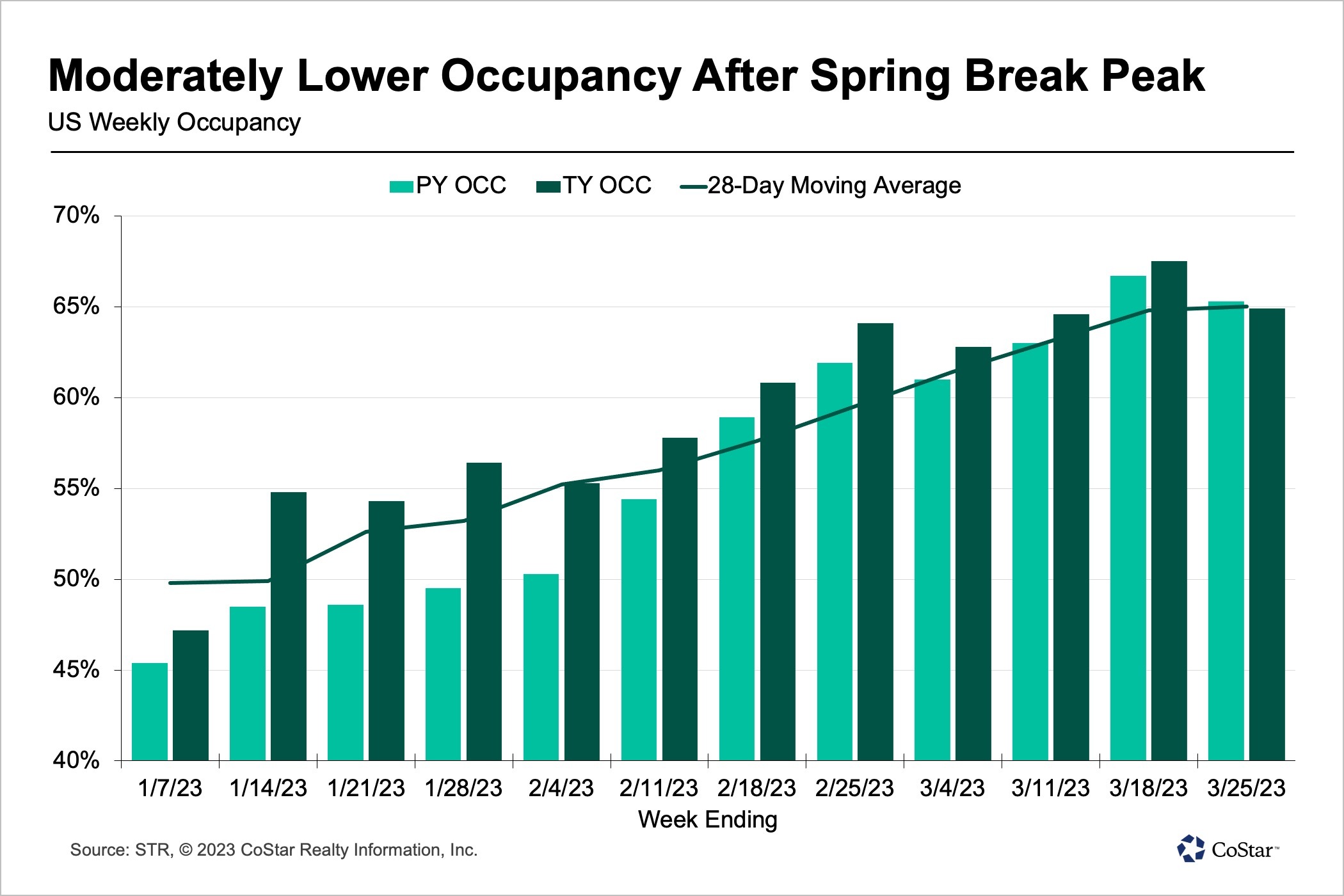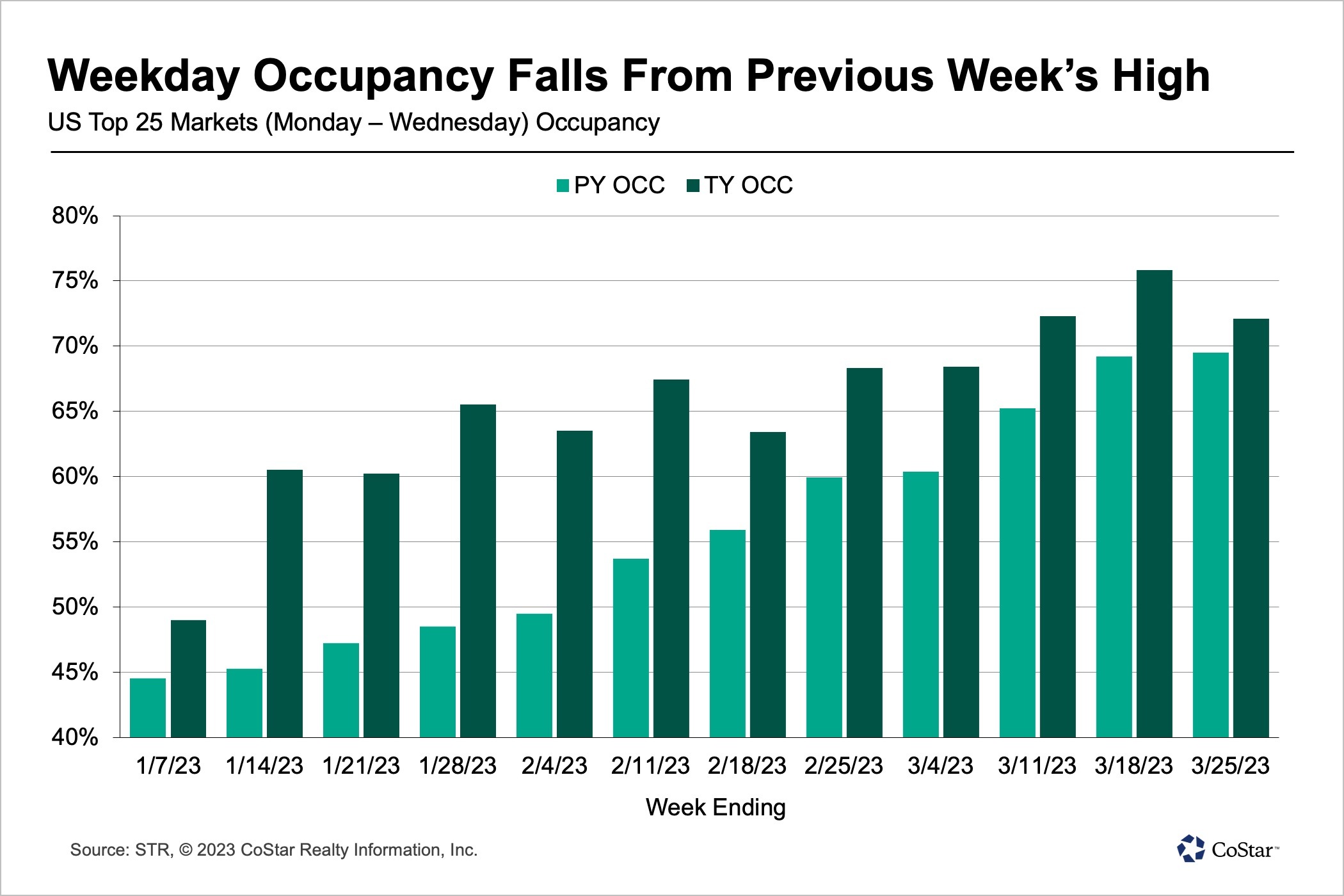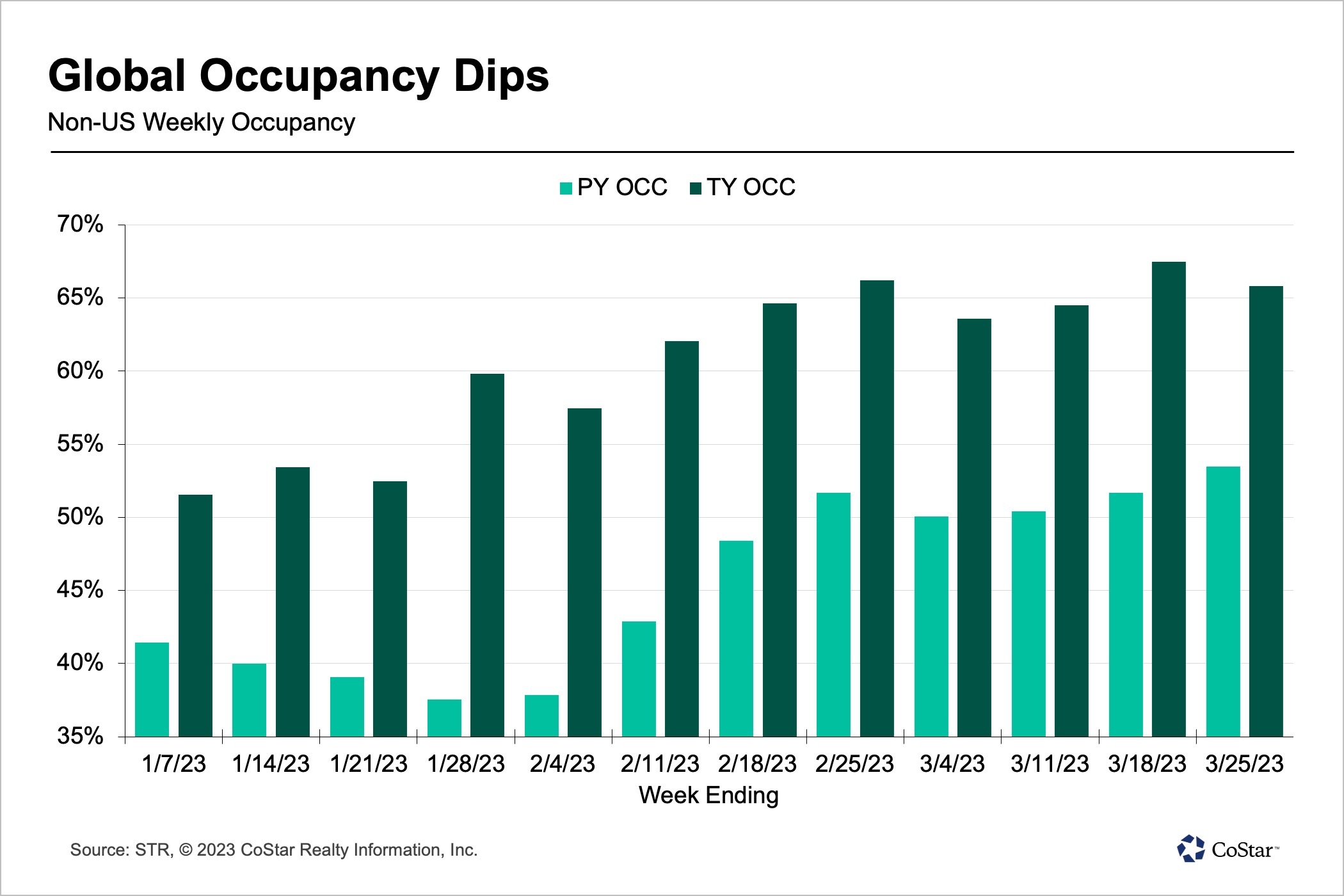After surging with the peak of spring break travel in the U.S., weekly global hotel performance expectedly dialed back.
Following seasonal patterns, key hotel performance indexes declined week over week, but the week ending March 25 still represented the second-best weekly performance so far in 2023 for the U.S. hotel industry, according to the latest data from STR, CoStar’s hospitality analytics firm.
Performance indicators across global markets also showed a small but not unexpected decline amid seasonal transitions, including the annual religious observance of Ramadan which contributed to reduced travel in Islamic countries.
Looking ahead, weekly U.S. hotel performance is expected to benefit from a pickup in family travel in the days leading to the Easter holiday. More of that travel will occur in larger markets than last year. This is counterbalanced by an expectation that business along with group bookings will slow closer to Easter Sunday.
Outside the U.S., the year-over-year comparisons will strengthen given the later recovery period along a more favorable comparison to the Ramadan period of last year.
US Performance
Coming off a strong week driven by the apex of spring break travel, the U.S. hotel industry throttled down in the week ending March 25. Week-over-week performance indicators fell, but this volatility is normal and in line with the seasonal patterns of previous years. Keeping with history, the next surge in performance is expected to occur in the week leading into Easter Sunday as family/vacation-oriented travel gains steam.
Weekly occupancy dropped to 64.9%, down from last week’s year-to-date peak of 67.5%. Despite the downshift, the weekly occupancy level was still the second-best recorded this year and since late October 2022.

Occupancy for the week decreased 0.4 percentage points from 65.3% a year ago. The decrease likely represents a return to normality given that last year’s leisure travel was overly robust after being limited by a surge in omicron cases of COVID-19. Supporting that view, room demand totaled 25.2 million rooms, the fourth highest for this particular week since 2000 and nearly equal to last year’s level despite falling by more than 1 million rooms week over week. The highest level ever achieved for this week occurred in 2019 when 26 million rooms were sold.
Average daily rate also fell from last week’s year-to-date peak of $167 to $159, which still ranks as second best in 2023. Weekly ADR grew 4.6%, or by $7, year over year, which is slightly off the 6% pace of recent inflation. Revenue per available room was $103 for the week, down 8.7% week over week and 4.1% higher than a year ago. Adjusting for inflation, real RevPAR was $86, compared to $94 a week ago.

Coming off a strong week, the top 25 U.S. hotel markets reported a 3.2-percentage-point decline in occupancy to 72.3%. That decline is consistent with historical weekly performance patterns as demand/occupancy normally recedes after peaking with spring break.
Weekday (Monday to Wednesday) occupancy was 72.1%, compared to 69.4% last year, which indicates that weekday business travel still maintained its recovery footing in the largest markets. Still, it is worth noting that there was a sizable 8-percentage-point gap in weekday occupancy compared to pre-pandemic 2019, when that metric was 80.1%. Weekend (Friday and Saturday) occupancy in top 25 markets was 78.8%, closer to the 2019 level of 82.7%, on the continued strength of leisure travel. Other notable performance includes:
- Week over week, hotel demand decreased nearly equally between the top 25 markets and all other markets, but year-over-year demand was up in the top 25 markets and down elsewhere.
- Weekly demand in four of the top 25 markets was the highest recorded for this particular week since 2000. Nashville hotels led in demand growth by selling 17.5% more rooms, but this was more than offset by the market’s 21.4% increase in room supply. Other markets showing weekly demand surpluses included Dallas, Boston and Miami.
- ADR across the top 25 markets increased 6.9% year over year to $190. Only three large markets posted year-over-year weekly ADR declines, including Miami, Los Angeles and New Orleans.
- Top 25 weekly RevPAR was $137, up 7.7% from last year, with weekday RevPAR increasing 13.4% to $137. In comparison, weekend RevPAR rose a restrained 2.2% to $156. Overall, 20 of the top 25 markets are indexing higher RevPAR than the same week 2019. Chicago led the week among large markets with indexed RevPAR 25% better than 2019.
- Outside of the top 25 markets, weekday occupancy remains generally stable relative to last year which, given substantial gains in the prior two years, is not concerning. Recent weekend occupancy in markets outside of the top 25 remained roughly 2 percentage points below last year, which can be an indication of slowing non-urban travel from prior peaks.
Seven of the 167 STR-defined U.S. markets reported occupancy above 80%, down from 19 markets in the prior week. This week’s occupancy was led by the Florida Keys at 85.9% and Palm Beach at 84%. Another 31 markets posted occupancy between 70% and 80%. Overall, 101 markets reported occupancy above 60%, down from 108 last week. Other notable market insights include:
- San Francisco hotels hit a high bar with weekly RevPAR of $200, only the fifth time in the pandemic era that the market has done so and the second time this year. Its two solid RevPAR weeks this early into 2023 provide early indication that the market is back on a more-level playing field after having being sidelined for much of 2021 and 2022.
- Double-digit annual RevPAR growth, which is an indication of vigorous recovery, occurred in 10 of the top 25 markets and 100 U.S. markets overall.
- Resort RevPAR is slowing with this week’s result down 6.8% year over year compared to all other location types, where RevPAR is up on average 7.4%. The decline among resorts was driven by decreases in both occupancy, down 3.2 percentage points, and ADR, down 2.6%. The decline was centered in markets outside of the top 25, where resort RevPAR fell 12.1% compared to a 2.9% decline in the top 25 markets. Resorts in the top 25 markets have shown better performance since the beginning of the year whereas resorts outside of the top 25 markets have posted year-over-year RevPAR decreases for the past five weeks, with this week’s decrease the largest so far this year.
Global Performance
Global hotel occupancy fell by 1.6 percentage points week-over-week to 65.8%, combining with a 1.2% dip in ADR ($131) for a 3.6% drop in RevPAR ($86). Compared to last year, occupancy was up 12 percentage points, with ADR increasing 17.1% and RevPAR growing 44%. This is the first time this year that RevPAR growth was less than 50% year over year.

Among the top 10 largest countries based on supply, the United Kingdom retook the lead with an occupancy of 75.9%. Japan was only a fraction of a percent behind. Indonesia dropped from the lead spot in occupancy to the bottom of the top 10 for current week as a result of the start of Ramadan, which began March 22. A shift in the Ramadan calendar — Ramadan did not begin until April 1 in 2022 — also contributed to Indonesia being the only top country to slip below last year’s occupancy level.
Spain and China both held strong with occupancies at or above 70%. Occupancy in China has now grown by several points each week since mid-March and shows no signs of slowing down. This week’s result was the highest since mid-July 2021. Germany had held the longest sustained growth in occupancy with a streak of six weeks trending upward, but faltered this week with a fractional dip in demand. Now, the U.K. leads the top 10 countries in that category, with three weeks of sustained occupancy growth.

Elsewhere, hotel occupancies fell in more countries than it grew this week. Guatemala topped the list for global occupancies at 81.4%, and Jamaica and the Bahamas remained above the 80% threshold as well. Only four countries have posted four or more consecutive weeks of week-over-week occupancy growth: Belgium, Luxembourg, Croatia and Switzerland, which leads the world with seven consecutive weeks of growth.
M. Brian Riley is senior research analyst at STR, Brannan Doyle is a research analyst at STR and Isaac Collazo is VP of analytics at STR.
This article represents an interpretation of data collected by CoStar's hospitality analytics firm, STR. Please feel free to contact an editor with any questions or concerns. For more analysis of STR data, visit the data insights blog on STR.com.
